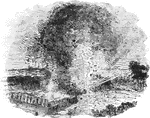Clipart tagged: ‘explosion’

Blowing Up Fort Hill Bastion
As June wore on, Grant pressed the siege with vigor. Johnston tried to help Pemberton, but could not.…

Destruction of Merrimac
"Destruction of the Confederate ironclad steamer Merrimac, blown up by its commander, on the…

The Great Naval Battle of the Mississippi
Passage of the second division of the Federal Squadron past Fort St. Philip. On April 24, 1862 at three…

Percussion Torpedo
The torpedoes used by the Confederates were various in form and construction. The most efficient ones…

Short Cartridge - Copper Case
"A cartridge containing shot instead of a bullet, and intended to serve various purposes. a, copper…

Torpedo Net
The steam-vessels were protected by torpedo-nets formed of ropes weighted with iron or lead, and furnished…

Siege of Vicksburg
"Siege of Vicksburg- the fight in the crater of Fort Hill after the explosion, June 27th, 1863. Our…